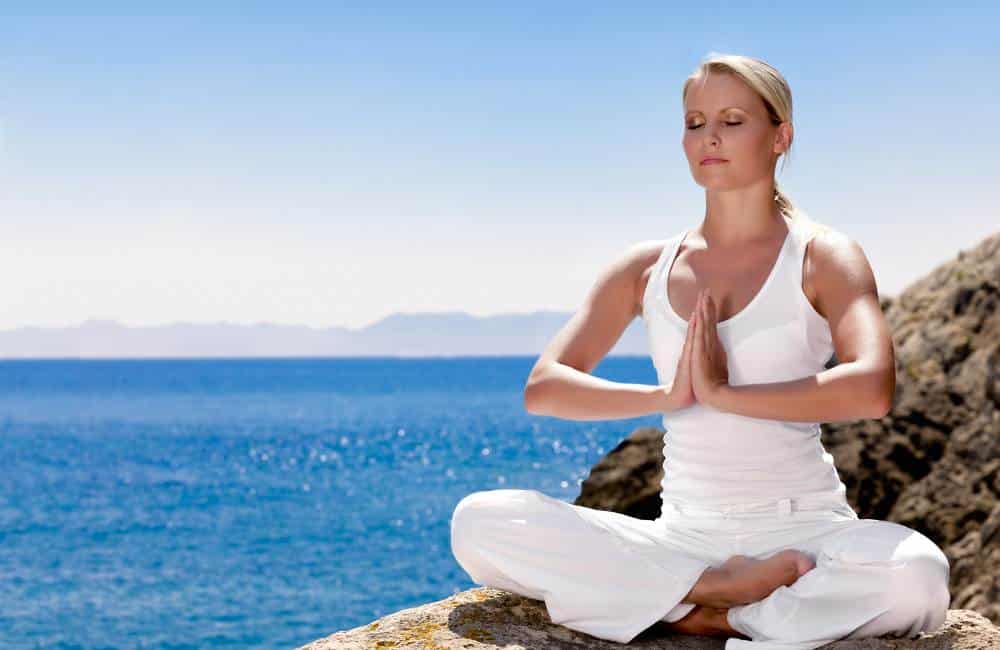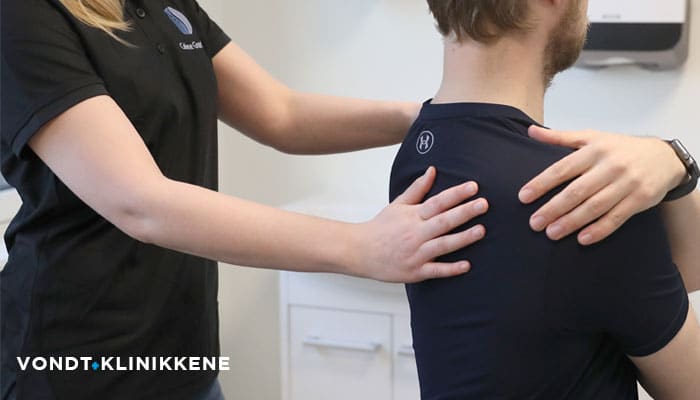Stress and fibromyalgia: 6 ways to reduce stress
Last updated 28/02/2024 by The pain clinics - Interdisciplinary Health
Stress and fibromyalgia: 6 ways to reduce stress
Stress and fibromyalgia are not a good combination. High levels of stress can contribute to worsening symptoms and pain.
Fibromyalgia is a chronic pain syndrome that characteristically causes severe and widespread pain, as well as other symptoms such as sleep disturbances and brain fog. Research has shown that stress can play a central role in fibromyalgia.¹ Stress can affect how we experience pain through neurochemical changes in the body - which in turn lead to increased pain signals and worsening symptoms. In this article, we want to take a closer look at a number of measures and relaxation methods to reduce stress.
Tips: Later in the article shows chiropractor Alexander Andorff you a gentle mobility program that can help to dissolve muscle tension in the back and neck.
Stress weakens the body

Because fibromyalgia involves chronic pain, the body is in a varying 'stressed state'. Which in turn means that people with this diagnosis can be more strongly affected by stress. In short, stress weakens the body and makes us more vulnerable to chronic pain, fatigue (extreme exhaustion) and cognitive disorders (such as fibrous mist). There is no doubt that high levels of stress and fibromyalgia are a bad combination.
- Many people do not take enough care of themselves
It is not easy to live with chronic pain and what is classified as 'invisible illness'. And reducing stress in everyday life is often far more difficult than you think. Many people with fibromyalgia do not put themselves and their health first - and thus end up in an uncomfortable situation where the symptoms take over. Making certain lifestyle changes to take care of yourself and get enough rest is incredibly important if you have fibromyalgia.
6 ways to reduce stress (and associated fibromyalgia symptoms)

In the next part of the article, we will take a closer look at six measures and methods to reduce stress. Here we remind you that we are different - and that what gives relief or relaxation is often subjective. But let's take a closer look at the six measures below:
Training in a warm water pool
Customized training (incl knitwear training og yoga)
Self-time and mindfulness
Relaxation massage and intramuscular acupuncture (dry needling)
Hot bath
Sleep training
For most people, all six of these points are highly relevant. But here it also applies that you take a journey with yourself and find out which measures and techniques work best for you.
1. Training in a hot water pool

We have previously written an article about exercise in a warm water pool and fibromyalgia. This form of training has several advantages, including the fact that it is often carried out under the auspices of rheumatic groups and is carried out in warm water. Here you can meet like-minded people and exchange experiences, while also getting a training session that takes into account the fact that you suffer from a chronic pain diagnosis. The warm water helps to increase blood circulation in the muscles - and makes the training exercises more gentle and adapted.
Our clinic departments at Vondtklinikkene (click here for a complete overview of our clinics), including in Oslo (Lambert seats) and Viken (Eidsvoll Sound og Raw wood), has a distinctively high professional competence in the investigation, treatment and rehabilitation of pain in muscles, tendons, nerves and joints. Toe contact us if you want help from publicly authorized therapists with expertise in these fields.
2. Adapted and gentle training
Many people with fibromyalgia feel that the body becomes overwhelmed and overloaded if they exercise too hard. Which in turn can trigger a bad period with increased symptoms and pain. This is precisely why it is so important that the training load does not exceed one's own load capacity. Forms of gentle exercise can include yoga, training with elastic and walks. Again, we want to emphasize the need for individual adaptations - including medical history and daily form.
Recommendation: Training with elastic band (link opens in a new browser window)
For people who are sensitive to exercise, exercise with elastic bands is recommended. In fact, this form of training has documented positive effects for people with fibromyalgia, among others (read: Fibromyalgia and elastic training). Press the image or here to learn more about the pilates band.
3. Self-time and mindfulness

Self-time doesn't have to mean meditating on a mountain with a sea view - but it does paint a very clear picture that you sometimes have to take time for yourself. And if you have fibromyalgia, this is extra important in order not to let the stress reactions in the body get the better of you. Self-time can also mean doing things you like - we recommend at least 30-45 minutes focusing on a hobby or interest you are fond of.
Mindfulness is a relaxation technique where you try to let your thoughts and brain calm down your body with conscious techniques. Breathing techniques can also be used here, preferably performed on trigger point mat or with neck relaxation pillow, be good ways to calm down.
"Relaxation and alone time can come in many different forms - and for some this means, for example, needlework (crocheting, knitting and the like)."
4. Relaxation massage and intramuscular acupuncture

It is no well-kept secret that people with fibromyalgia are significantly troubled by muscular tension and tension. It is also on this basis that you also need physical treatment to dissolve muscle knots, reduce muscle tension and reduce pain sensitivity. And here it is important that the treatment is not too harsh. Studies have shown that massage and muscle work reduce the pain signaling substance substance P and contributes to better sleep in fibromyalgia patients.²
– Acupuncture for relaxation?
Meta-analyses have also shown that dry needling, also known as intramuscular needling, aimed primarily at trigger points, has a number of positive effects on symptoms of fibromyalgia.³ It was shown, among other things, to reduced pain sensitivity, less anxiety and depression, reduced fatigue and better sleep (short-term effect which means that the treatment must be repeated at certain intervals).
- Pain clinics: We can help you with pain in muscles and joints
Our publicly authorized clinicians at our affiliated clinics The pain clinics has a distinctive professional interest and expertise in the investigation, treatment and rehabilitation of muscle, tendon, nerve and joint ailments. We work purposefully to help you find the cause of your pain and symptoms - and then help you get rid of them.
5. Hot bath (or shower)

Sometimes simple is the best. A warm water can help reduce stress hormones and increase endorphin levels in the body (the body's natural pain reliever). The warm water helps to dissolve tense muscles by increasing circulation to the areas. Others also report that they experience the sauna as an effective relaxation measure.
6. Sleep training

Unfortunately, sleep problems and reduced sleep quality are familiar problems for many people with fibromyalgia. Previously, we wrote an article with 9 tips for better sleep with fibromyalgia - where we go through the specific advice from a doctor specializing in sleep problems. Improved sleep can have a significant positive impact on the stress levels in your body – and thus your symptoms.
Summary: Stress and fibromyalgia
Fibromyalgia is an incredibly complex pain syndrome that is affected by many different factors. Stress – including physical, psychological and chemical stress – is a known trigger for worsening symptoms and pain. This is precisely why it is so important that you recognize this and try to weed out factors in your everyday life that give you high shoulders and stress you out.
VIDEO: 5 gentle mobility exercises
In the video above, you will see 5 adapted and gentle mobility exercises. These can help you stimulate movement in stiff joints and loosen tense muscles. The training program can be carried out daily.
Join our rheumatism and chronic pain support group
Feel free to join the Facebook group «Rheumatism and Chronic Pain - Norway: Research and news» (Press here) for the latest updates on research and media articles on rheumatic and chronic disorders. Here, members can also get help and support - at all times of the day - through the exchange of their own experiences and advice. Otherwise, we would greatly appreciate it if you would follow us on the Facebook page and Our Youtube channel (the link opens in a new window).
Please share to support those with rheumatism and chronic pain

Hello! Can we ask you a favor? We kindly ask you to like the post on our FB page and to share this article on social media or via your blog (please link directly to the article). We are also happy to exchange links with relevant websites (contact us on Facebook if you want to exchange links with your website). Understanding, general knowledge and increased focus is the first step towards a better everyday life for those with rheumatism and chronic pain diagnoses. So we hope that you will help us in the future with this battle of knowledge!
The pain clinics: Your choice for modern interdisciplinary health

Our clinicians and clinic departments always aim to be among the top elite in the field of investigation, treatment and rehabilitation of pain and injuries in muscles, tendons, nerves and joints. By pressing the button below, you can see an overview of our clinics - including in Oslo (incl Lambert seats) and Viken (Raw wood og Eidsvoll Sound).
Sources and Research
1. Houdenhove et al, 2006. Stress, depression and fibromyalgia. Acta Neurol Belg. 2006 Dec;106(4):149-56. [PubMed]
2. Field et al, 2002. Fibromyalgia pain and substance P decrease and sleep improves after massage therapy. J Clin Rheumatol. 2002 Apr;8(2):72-6. [PubMed]
3. Valera-Calero et al, 2022. Efficacy of Dry Needling and Acupuncture in Patients with Fibromyalgia: A Systematic Review and Meta-Analysis. Int J Environ Res Public Health. 2022 Aug 11;19(16):9904. [PubMed]
Article: Stress and fibromyalgia: 6 ways to reduce stress
Written by: Our publicly authorized chiropractors and physiotherapists at Vondtklinikkene
Fact check: Our articles are always based on serious sources, research studies and research journals - such as PubMed and the Cochrane Library. Please contact us if you spot any errors or have comments.
FAQ: Frequently asked questions about stress and fibromyalgia
1. How can I get control of my stress?
Well, the first step is to take a step back and actually acknowledge that you are stressed. It is then necessary to weed out the factors that cause you a lot of stress - and set up your everyday life so that you also have time to take care of yourself.







Leave a reply
Want to join the discussion?Feel free to Contribute!